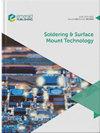热压焊全Cu3Sn-微孔铜复合材料接头的组织演变和剪切强度
IF 1.8
4区 材料科学
Q3 ENGINEERING, ELECTRICAL & ELECTRONIC
引用次数: 0
摘要
目的快速制备适用于高温电力电子应用的全Cu3Sn微孔铜复合接头,并研究不同接合时间下Cu3Sn的微观结构演变和剪切强度。设计/方法/途径本文设计了一种新型的Cu/复合钎料片/Cu结构。复合焊片由填充锡的微孔铜制成。复合接头在0.6的压力下通过热压接合进行接合 300°C时的MPa。用电子显微镜和金相显微镜观察了Cu3Sn在不同结合时间的组织演变和生长行为。用剪切机测定了接头的剪切强度。发现在初始键合阶段,基底中的铜原子和微孔铜中的铜离子溶解在液体Sn中,然后在液体Sn/微孔铜和液体Sn/Cu基底的界面处形成扇形Cu6Sn5相。在液态Sn转变为Cu6Sn5相的过程中,Cu3Sn相在Cu6Sn5/Cu衬底与Cu6Sn5/微孔铜的界面形成并生长。之后,Cu3Sn相继续生长,并且厚度为100 µm。Cu3Sn的生长规律为抛物线生长。复合材料接头的抗剪强度约为155 MPa.Originality/value本文提出了一种基于瞬态液相键合的新型高温应用高剪切强度全Cu3Sn微孔铜复合接头。研究了Cu3Sn在复合材料接头中的组织演变和生长行为。研究了复合材料节点的抗剪强度和断裂机理。本文章由计算机程序翻译,如有差异,请以英文原文为准。
Microstructure evolution and shear strength of full Cu3Sn- microporous copper composite joint by thermo-compression bonding
Purpose
The purpose of this paper is to quickly manufacture full Cu3Sn-microporous copper composite joints for high-temperature power electronics applications and study the microstructure evolution and the shear strength of Cu3Sn at different bonding times.
Design/methodology/approach
In this paper, a novel structure of Cu/composite solder sheet/Cu was designed. The composite solder sheet was made of microporous copper filled with Sn. The composite joint was bonded by thermo-compression bonding under pressure of 0.6 MPa at 300°C. The microstructure evolution and the growth behavior of Cu3Sn at different bonding times were observed by electron microscope and metallographic microscope. The shear strength of the joint was measured by shear machine.
Findings
At initial bonding stage the copper atoms in the substrate and the copper atoms in the microporous copper dissolved into the liquid Sn. Then the scallop-liked Cu6Sn5 phases formed at the interface of liquid Sn/microporous copper and liquid Sn/Cu substrates. During the liquid Sn changing to Cu6Sn5 phases, Cu3Sn phases formed and grew at the interface of Cu6Sn5/Cu substrates and Cu6Sn5/microporous copper. After that the Cu3Sn phases continued to grow and the Cu3Sn-microporous copper composite joint with a thickness of 100 µm was successfully obtained. The growth rule of Cu3Sn was parabolic growth. The shear strength of the composite joints was about 155 MPa.
Originality/value
This paper presents a novel full Cu3Sn-microporous copper composite joint with high shear strength for high-temperature applications based on transient liquid phase bonding. The microstructure evolution and the growth behavior of Cu3Sn in the composite joints were studied. The shear strength and the fracture mechanism of the composite joints were studied.
求助全文
通过发布文献求助,成功后即可免费获取论文全文。
去求助
来源期刊

Soldering & Surface Mount Technology
工程技术-材料科学:综合
CiteScore
4.10
自引率
15.00%
发文量
30
审稿时长
>12 weeks
期刊介绍:
Soldering & Surface Mount Technology seeks to make an important contribution to the advancement of research and application within the technical body of knowledge and expertise in this vital area. Soldering & Surface Mount Technology compliments its sister publications; Circuit World and Microelectronics International.
The journal covers all aspects of SMT from alloys, pastes and fluxes, to reliability and environmental effects, and is currently providing an important dissemination route for new knowledge on lead-free solders and processes. The journal comprises a multidisciplinary study of the key materials and technologies used to assemble state of the art functional electronic devices. The key focus is on assembling devices and interconnecting components via soldering, whilst also embracing a broad range of related approaches.
 求助内容:
求助内容: 应助结果提醒方式:
应助结果提醒方式:


